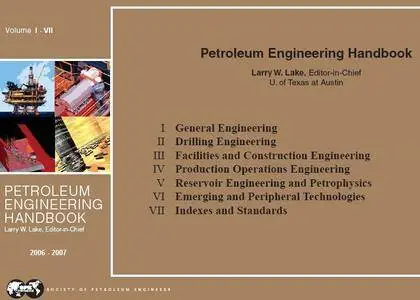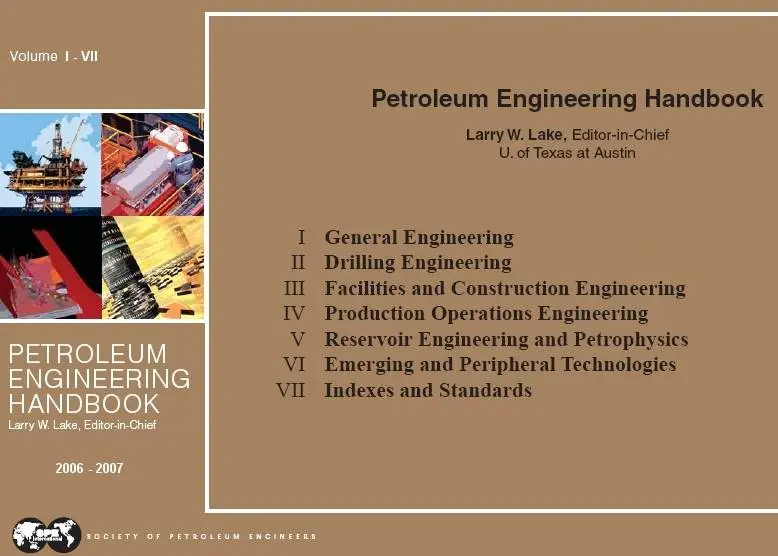"Petroleum Engineering Handbook, Volumes 1 - 7 set" by Larry W. Lake, Editor-in-Chief
Society of Petroleum Engineers
Society of Petroleum Engineers | 2007 | ISBN: 1555631266 1555631274 1555631355 9781555631352 9781555631277 9781555631260 | 5625 pages | PDF | 543 MB
Society of Petroleum Engineers
Society of Petroleum Engineers | 2007 | ISBN: 1555631266 1555631274 1555631355 9781555631352 9781555631277 9781555631260 | 5625 pages | PDF | 543 MB
This Handbook has long been recognized as a valuable, comprehensive reference that offers practical day-to-day applications for students and experienced engineering professionals alike.
vol.1 "General Engineering"
This volume includes chapters on mathematics, fluid properties (fluid sampling techniques; properties and correlations of oil, gas, condensate, and water; hydrocarbon phase behavior and phase diagrams for hydrocarbon systems; the phase behavior of water/hydrocarbon systems; and the properties of waxes, asphaltenes, and crude oil emulsions), rock properties (bulk rock properties, permeability, relative permeability, and capillary pressure), the economic and regulatory environment, and the role of fossil energy in the 21st century energy mix.
The volume has been designed to present material that is needed by all practicing petroleum engineers. It includes chapters on mathematics, properties fluids, rock properties, rock/fl uid interactions, economics, the law, and the social context of fossil energy. The mathematics chapters of this volume are a major departure from previous editions. The mathematical tables presented in previous editions are now readily available using hand-held calculators or software on desktop computers. The mathematics chapters present mathematical topics that petroleum engineers need to better understand literature and the software they use on a day-to-day basis. Topics such as vibrating systems, ordinary and partial differential equations, linear algebra and matrices, and Green’s functions are introduced and references are provided for readers who would like to pursue the topics in more detail. The discussion of fluid properties covers fluid sampling techniques; properties and correlations of oil, condensate, and water; hydrocarbon phase behavior and phase diagrams for hydrocarbon systems; and the phase behavior of water/hydrocarbon systems. Two chapters consider the properties of waxes, asphaltenes, and crude emulsions. Rock properties and rock/fluid interactions are discussed. The rock properties include bulk rock properties, such as porosity, elastic rock properties, and rock failure relationships. Measurement techniques and models of singlephase permeability are then presented, followed by a review of the properties that describe the interaction between rocks and fluids, notably relative permeability and capillary pressure. In addition to mathematics, fluid properties, and rock properties, petroleum engineers need to understand economic and legal issues. Essential aspects of the economic and regulatory environment are addressed in the section. A brief review of the role of fossil energy in the 21st century energy mix ends the volume.
vol.2 "Drilling Engineering"
This volume is the first drilling content to be included in the Petroleum Engineering Handbook; chapters clarify the state of the drilling art at the beginning of the 21st century.
Topics included are:
* Drilling Geoscience
* Drilling Fluids
* Drilling Fluid Mechanics
* Well Control
* Bit Selection
* Directional Drilling
* Casing Design
* Wellhead Design
* Cementing
* Drilling Problems
* Well Planning
* Underbalanced Drilling
* Emerging Technologies
* Marine Drilling
* Data Acquisition and Interpretation
* Coiled Tubing
vol.3 "Facilities and Construction Engineering"
Facilities engineering is a broad specialty embracing all of the classic engineering specialties such as civil, chemical, mechanical, and instrument/electrical, as well as the broad science of project management. Authors have attempted to provide the non-facilities engineer with a basic understanding of the equipment and systems we use, how they work, the relative advantages and disadvantages that aid in choosing between alternatives for a specific set of conditions, and a better understanding of the terminology so that those with a general knowledge can interface more effectively with experts in each of the different subspecialties.
vol.4 "Production Operations Engineerings"
This volume is designed to replace the production engineering chapters found in the 1987 edition of the Handbook. There have been significant changes in technology and operating practices in the past 20 years, and these new chapters will bring you up to date in the areas of design, equipment selection, and operation procedures for most oil and gas wells.
The 16 chapters in this volume are divided into three groups. The first section, on well completions, includes discussions of inflow and outflow performance; completion systems; tubing selection, design, and installation; perforating; and sand control. The next group of chapters deals with the problems caused by formation damage; topics include formation damage, matrix stimulation, hydraulic fracturing, and well production problems. The final chapters address the subject of artificial lift, a major concern for production engineers. Subjects mentioned include artificial lift selection, sucker-rod lift, gas lift, electrical submersible pumps, hydraulic pumping in oil wells, progressing cavity pumping systems, and plunger lift.
vol.5 "Reservoir Engineering and Petrophysics"
This book dealing with reservoir rock and fluid properties. These include acquiring and interpreting data that describe reservoir rock and fluid properties; acquiring, understanding, and predicting fluid flow in the reservoir; interpreting measurements of well performance; calculating the factors that impact both primary and improved recovery mechanisms from oil and gas reservoirs; estimating reserves and calculating project economics; simulating reservoir performance; and structuring and measuring the effectiveness of a reservoir management system.
This volume consists of 27 chapters that deal with the many aspects of reservoir engineering. The chapters were assembled to provide information on acquiring and interpreting data that describe reservoir rock and fluid properties; acquiring, understanding, and predicting fluid flow in the reservoir; interpreting measurements of well performance; calculating the factors that impact both primary and improved recovery mechanisms from oil and gas reservoirs; estimating reserves and calculating project economics; simulating reservoir performance; and structuring and measuring the effectiveness of a reservoir management system. These chapters have been written as a handbook and, as such, assume that the reader has a familiarity with fundamentals and some experience in the production of hydrocarbons and will use this publication as a refresher or to expand knowledge in certain areas of technology. Extensive references in each chapter indicate the amount of material that has been considered and distilled.
vol.6 "Emerging and Peripheral Technologies"
Volume VI contains 12 chapters that describe the unique technology developed either in niches on the periphery of existing petroleum engineering subjects or as emerging areas of technology, technologies that were not covered in the 1987 edition of the Handbook.
Emerging technologies covered include:
* Smart Wells
* Subsea and Downhole Processing
* Monetizing Stranded Gas
* Hydrate Emerging Technolgies
* Electromagnetic Heating of Oil
Peripheral technologies covered include:
* Reservoir Geophysics
* Geologically Based, Geostatistical Reservoir Modeling
* Cold Heavy Oil Production With Sand
* Coalbed Methane
* Tight Gas Reservoirs
* Geothermal Engineering
* Risk and Decision Analysis
vol.7 "Master Indexes and Metric Standards"
This final volume of the Petroleum Engineering Handbook contains a collection of indispensable resources, including master author and subject indexes for Volumes 1 through 6; the SPE Symbols Standard, and the SPE SI Metric Conversion Factors Standard. Includes bibliographical references and indexes.
true PDFs with TOC BookMarkLinks



